2019 Activity Report
March Activity Report
31 March 2020
Global Japan Office Coordinator
TAKEMORI Banri
March is the season when the cold has eased off and should be the best time for outings. But fears for the globally spreading novel coronavirus have dampened the joyous mood of spring.
I do not think it likely that European countries, including the Netherlands, regarded the coronavirus as a threat until January. News on the rapidly increasing number of patients in Italy sounded like somebody else’s problem. At that time, we were following Japan’s situation and worried that our three-month study abroad program in Japan might be canceled (most of the second-year students in the Japanese Studies department of Leiden University were supposed to go on this short-term study abroad program), but we thought it was safe to stay where we were. Since the first case of infection in the Netherlands was reported on February 27, we have quickly surpassed Japan in both the infection rate of the population and in the actual number of infections.
The Japanese Speech Contest was scheduled for the second Saturday of March by the Japanese Embassy. We had our last practice session on the previous Friday. Six people were supposed to enter the speech contest, but only two appeared that day. A few days before that, the university decided to cancel the study abroad program in Japan for second-year students. The notice of the cancellation was announced via email during a class. During a break after the class, some students who saw the email got upset and started crying, and the classroom was in a state of turmoil. It was no wonder that there were only two students who came to the practice session; I assumed that the second-year students were too upset to join the practice. So when J, the only sophomore participating in the session said, “There aren’t many people today,” I wasn’t particularly worried. However, J continued, “Have you heard? The speech contest has been postponed.” It was a bolt out of the blue for me. On that day, the embassy informed the participants of the postponement. In retrospect, it seems obvious that this would happen, but at the time I was surprised because I didn’t fully realize the gravity of the coronavirus outbreak.
After discussing the matter among teachers the next week, we decided to hold a “trial performance” on Thursday that week (instead of the rehearsal that was initially planned) considering the possibility of the cancellation of the speech contest. On the day of the trial performance, three students delivered powerful speeches before the audience. The teachers and the Japanese audience had prepared gifts beforehand for the participants such as books, stationery, and some sweets. They ranked the three speakers and gave them prizes accordingly. The Japanese audience consisted of visiting students, teachers, and people from the Ministry of Foreign Affairs, all of whom wrote careful and thoughtful notes on the feedback sheets for each presenter. They also asked precise questions and made comments on each speech, making the event warm and friendly.
After the event, a student abruptly said that there would be no classes the next day. We couldn’t believe our ears. I hurried to the university’s website and saw the cancellation of classes had been announced. We spent the weekend worrying. On Sunday the Dutch government issued a decree that “horeca” (hotels, restaurants, cafes, etc.) will be closed until at least the beginning of April. On Monday, the university decided to hold classes online until things calm down. That evening, Dutch Prime Minister Mark Rutte gave a speech to the whole nation. It was the first time since the oil crisis in 1973 that the head of the country made a speech directly to the people. Until just a few days ago, I thought people were living a normal, carefree life, but I was mistaken. By the time I realized it, things had become very serious.
But the good thing about being in the Netherlands is that we don’t have a stay-at-home order like France and Italy. In the last two weeks of March, the usual rainy weather in the Netherlands was cleared up as if by magic, and we had a string of sunny days. With the sunshine luring them out, no one can stop the Dutch, who have a habit of relaxing on cafe terraces in the sun, from going out. Even though cafes and restaurants are closed, I often see people basking in the sun with tables and chairs in the courtyards and sidewalks of their homes, drinking with friends and family.
However, supermarkets and other stores that took moderate measures have now placed plastic boards in front of the cashiers to distance staff from customers. Some stores require shoppers to push large shopping carts to practice the 1.5-meter social distancing rule. Nobody can predict how serious the situation will get from now on.
It is the height of Spring outside, and the yellow forsythia and magnolias are in full bloom. The cherry trees have already bloomed in front of St. Pieterskerk Church near the university. I’ll end this entry with some pictures of them.
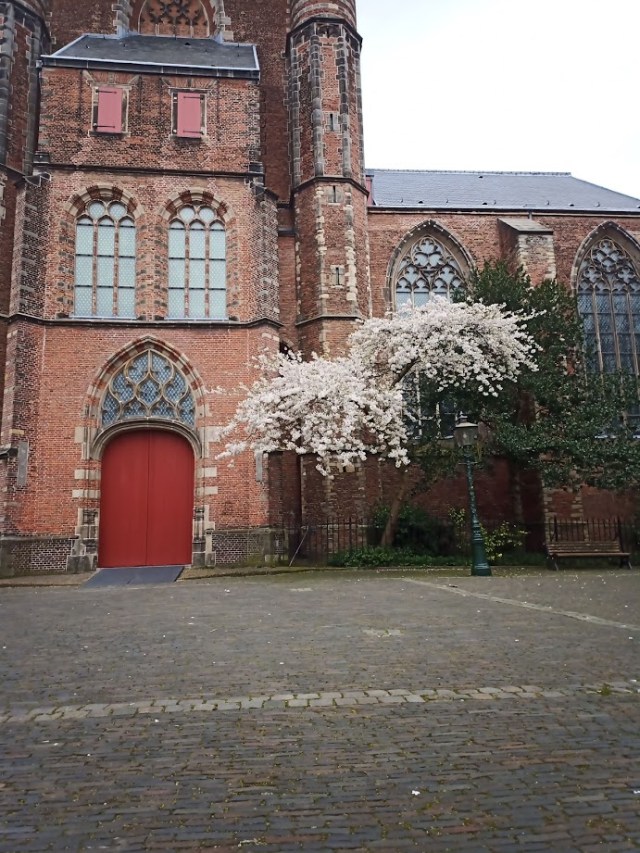
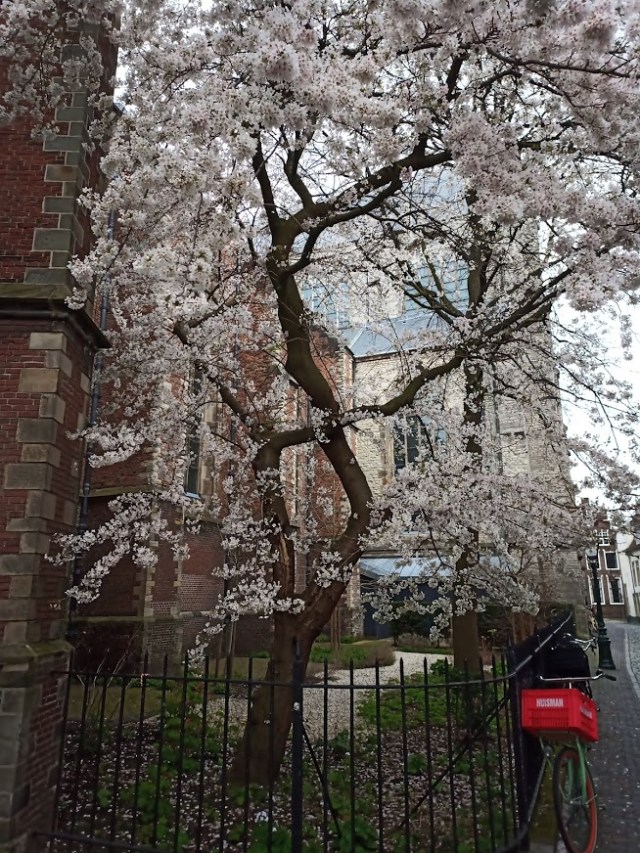
February Activity Report
29 February 2020
Global Japan Office Coordinator
TAKEMORI Banri
In February, the temperature in the Netherlands is still below 10 degrees Celsius, but the days get longer and flowers start to bloom here and there, making it all spring-like in the blink of an eye compared to January. Until January, all the flowers you could see were either the small white flowers of laurustinus and the yellow flowers of winter jasmine. But by the end of February, bright yellow daffodils and purple and white crocuses were blooming all at once in the green areas and parks along the canal, adding colors to the city. Due to the warm air on sunny days, the terrace seats at bars and cafes are gradually attracting people and regaining liveliness reminiscent of last summer.
February is also the month when winter vacation ends and the second semester begins. From the end of January, teachers have meeting after meeting to prepare for the new semester. With classes, preparation for classes, and more classes, February passed by like an arrow. At the Hague Campus of the University of Leiden where I teach, first year students begin their language classes in the second semester. At first, they were full of energy and enthusiasm, but by the end of February, they began to show signs of fatigue from their struggles with the Japanese language, which is structurally far from European languages and has different writing systems. The Japanese classes don’t have any exams or classes during the week of the mid-term exams in March, so the students and us teachers will be able to have a break.
There were two activities at the GJO this February. The first was to prepare for the Japanese speech contest held by the Japanese Embassy in the Netherlands in March. Every year, students from Leiden University win prizes in this competition. At first, there were no applicants even after the due date, so we extended the deadline, and in the end, six students applied. Following this, I called for Japanese exchange students who could help me, and we had a meeting with all of them to decide on practice policies, the deadline for the first draft, and the date and time for the practice sessions. After that, we held practice sessions on February 21 and 28, where we polished the speech drafts and practiced delivering the speeches. Some of the speeches covered unique topics, such as the students’ experiences playing in heavy metal bands while studying in Japan, or participating in the Yosakoi Soran Festival, a Japanese dance festival with a long history. It was fun listening to the speeches.
The second activity was a workshop on hand-rolled sushi on February 25, hosted by a Japanese restaurant in Leiden called Fujiyama 55 in cooperation with the Japanese conversation club. Seven Dutch students from Leiden University participated and enjoyed learning how to make Temaki-zushi. I couldn’t go there because of my schedule, but two Japanese exchange students who run the conversation club attended the workshop and reported about it later. The opportunity to learn how to make hand-rolled sushi from a professional was a valuable experience, and everyone enthusiastically participated. Next month we have the speech contest. The Japanese Conversation Club will also host a workshop on music.
January Activity Report
31 January 2020
Global Japan Office Coordinator
TAKEMORI Banri
Fireworks light up the Netherlands throughout the New Year season. People freely set off fireworks along canals or in parks, as skyrockets are easily available. It seems that fireworks are forbidden before sunset, but you can hear the sound of fireworks and firecrackers in the middle of the day regardless. On New Year’s Eve, there was a roaring sound as if a war had erupted, and people were standing in front of bars and houses, wine glasses in hand, looking up at fireworks. On the side of the canal, I could see groups of people setting off fireworks, and on the road there were bonfires every ten or so meters. People were burning used fireworks.
As soon as this somewhat crazy season was over, we returned to our daily lives. But university hadn’t started yet. Around the middle of January, preparations for the new school term gradually began. Some people had make-up exams, others attended meetings, and before I knew it, it was already February.
Therefore, you could say that January is the time to plan for the future rather than the season for activities. This month, the GJO originally planned to prepare for the speech contest sponsored by the embassy, but we were a little behind schedule. It was only at the beginning of February that we finally received all applications. From now on I’m going to have practice sessions and rehearsals with exchange students.
The conversation club will hold a sushi workshop at the end of February at a Japanese restaurant in Leiden. Please wait until next month for the report.
December Activity Report
31 December 2019
Global Japan Office Coordinator
TAKEMORI Banri
The exam period here starts as soon as December arrives. In my class, we had exams in The Hague during the first week of December, and at Leiden in the second week. The semester starts in September and there are actually three months of classes, so it can be said that the semester ends quite early.
The atmosphere of the Christmas holidays was already in the city during the exam period. In Leiden, a skating rink was first set up on the canal in front of City Hall. The speed at which facilities for festivals are set up in here is remarkable. I think it was early December when I passed by the site to get to The Hague campus and saw them starting to build scaffolding on the canal. The skating rink was completed by that evening and opened the next day. Following this, a Christmas market was also built on the canal next to it. The Christmas market and skating rink are connected by small bridges, and these facilities were the highlights of festivities in Leiden. The home of the Christmas markets is Germany. Unfortunately, Leiden’s Christmas market is not that large, and some of the shops were selling items like bamboo fiber pillows, 3D mascaras, accessories, massage cushions, and other things which I had no idea as to what they have to do with Christmas.
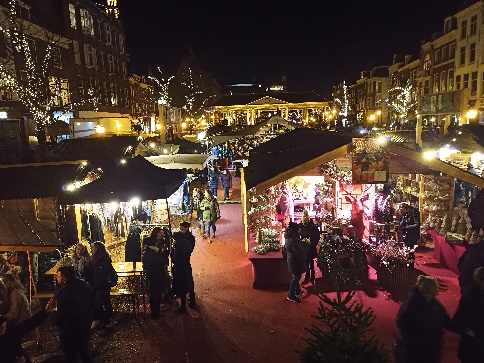
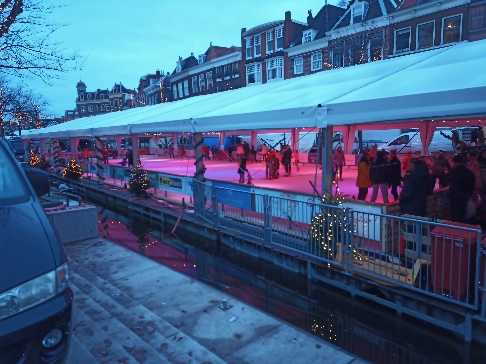
This month, students went on vacation as soon as the exams were over, so there wasn’t much activity at the GJO. With the exception of workshops where everyone gathers together, the Japanese Language Conversation Club divided into small groups to meet. At one of the workshops, students played Karuta (a Japanese traditional card game), which I also wanted to participate in, but unfortunately I had to supervise exams at The Hague that day.
Next month, preparation will begin for a speech contest sponsored by the Japanese Embassy in March.
November Activity Report
30 November 2019
Global Japan Office Coordinator
TAKEMORI Banri
In November, a mysterious figure called “Sinterklaas” lands in the Netherlands. Sinterklaas is similar but different from Santa Claus and is said to be the origin of the latter. This year, he landed in the Netherlands on November 17 and traveled around. This grizzled, long-beard man from Spain, with his red mitre, usually comes by steamboat, but this year news surfaced that he had entered the Netherlands by steam locomotive.
When I ask students about Sinterklaas, they all tell me that they believed in him during childhood. While Sinterklaas is in the country, Sinterklaas Houses are set up all over the country, and every year in Leyden, they are set up in a cafe called Waag, where you can meet Sinterklaas during the season. I have never been inside, but if you walk past the café, you’ll see little kids with paper mitre on their heads who seem to have just enjoyed contact with Sinterklaas.
Well, this month, the long-awaited first meeting of the Japanese conversation club was held on Friday the 1st. Because of the large number of participants, they were divided into two groups, beginner and intermediate/advanced, and enjoyed playing “fruit basket” and gesture games. After this meeting, the conversation club will be divided into small groups of about 10 people each, and they will gather at their own pace to enjoy Japanese conversation and games. At this first meeting, all the members got together, and my colleague, who was looking at them play “fruit basket” in an upbeat atmosphere, said that he could look at the students forever.
There was another event this month. It was a workshop on Saturday, November 30. About 30 people participated in this workshop. First, they were divided into small groups and had a discussion about the differences in Christmas celebrations and the weather between Holland and Japan. The results of the discussion were written on posters, and then the participants were asked to make brief presentations while looking at the posters. After that, they were divided into two groups and participated in workshops on calligraphy and tea ceremony in turns using two classrooms. I mainly watched the tea ceremony, and one of the visiting students, who had been learning tea since high school, dressed in a traditional kimono and introduced us to tea ceremony using PowerPoint slides, and demonstrated the ceremony. During the demonstration, she told the Dutch students to come closer if they wanted to see the tea, and many of them snuck up close and watched her making tea with great interest. For Japanese, while drinking matcha is not a daily experience, it is not such a rare sight to stare and marvel at. I felt that I was shown the attraction and lure different cultures hold for people.
In the calligraphy workshop, there were examples of calligraphy. But in the end, all the students wrote whichever characters they pleased by holding a smartphone displaying the kanji in their open hand. Some students drew maps of Japan and others wrote their names in kanji.
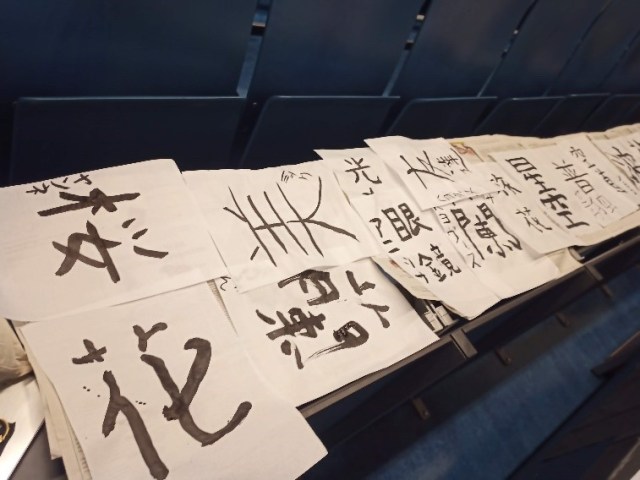
When November ends, the exam period begins followed by the Christmas season. In the city, Christmas decorations have already been put on the walls of houses (one humorous one is a Santa doll displayed upside down on the wall of a house, as if he had failed to climb the wall), and Christmas trees have begun to line up in front of supermarkets and florists.
October Activity Report
31 October 2019
Global Japan Office Coordinator
TAKEMORI Banri
The beginning of October was “3 October Festival” which lasted for about three days from the night of October 2nd. The town is completely different from usual during the festival, which commemorates Leiden’s defeat of the Spanish army, who sieged the city during the eight-year war. Stalls are set up in front of the station, an amusement park is set up in the square in front of Kaasmuseum, and a barge nightclub is built on top of the canal. The population of Leiden went out, and there were so many people that they could hardly move around, just like firework festivals in Japan. In some places, police officers on horseback controlled the traffic with bitter faces.
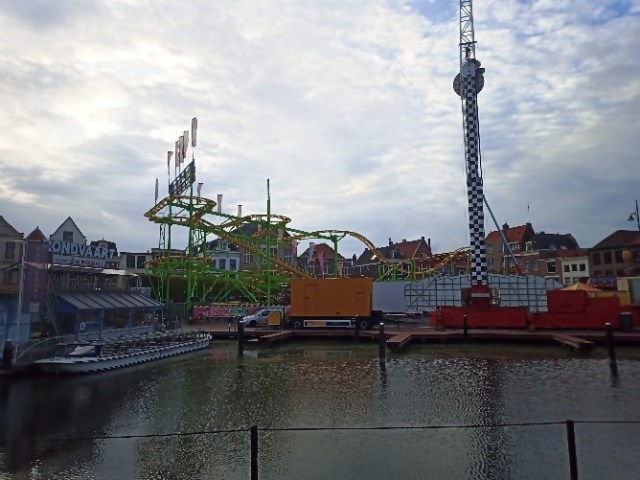
There were other events this month that made me feel the power of the people. Farmers protested against the government’s policy to control nitrogen emissions as a measure against environmental problems. Hundreds of tractors, rhythmically honking their horns, trooped into the city like tanks and marched, appealing to the masses that agriculture is the linchpin of the nation. There were also people cheering with their fists in the crowd along the route, and the atmosphere was filled with heat, despite the sky being cloudy and drizzling. Smoke rose from the exhaust pipe on the upper part of the tractors, and I keenly felt that Europe, which has an image of being advanced in environmental issues, is not monolithic. The protest took place over several days, and some students were unable to attend classes because the roads were occupied by tractors.
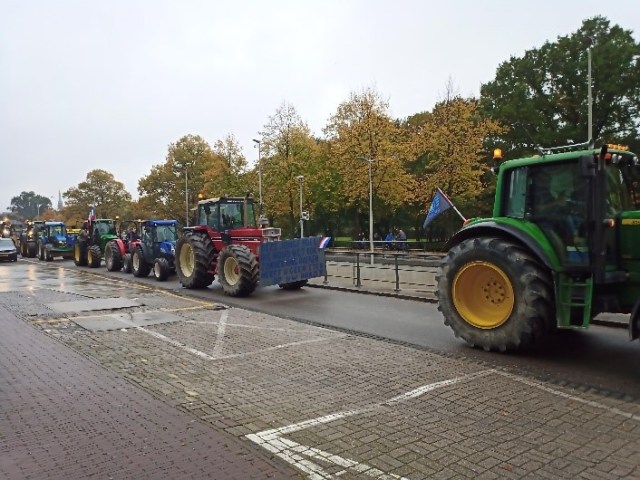
Let’s move on to a peaceful topic. The Japanese conversation club started this month. The first meeting was held on October 8 in a classroom at Lipsius (a modern building, which is rare amongst Leiden campus’s many old buildings) on the Leiden campus. Japanese students volunteered to prepare powerpoints, and we asked the Dutch students what they would like to do at this conversation club.
Most of the participants were first-year students, but there were also many opinions from the few second-year students. The second year students will be studying in Japan for a short period of time in a few months, so it was impressive to hear that they wanted to know about some of the cultural differences in daily life between Holland and Japan. Some of the whimsical opinions were that they wanted to form a band with people who could play instruments.
The basic idea of this term’s conversation club is to group by level and, if each group can do it every week, hold a workshop once a month or so. The Japanese students playing central roles in planning the activities of the club did share with me how they thought it would be better if there were weekly activities for Dutch students, but the total number of students may be too large.
A fellow teacher who works for the conversation club says that the Japanese students are enthusiastic and that this year the Dutch students are lucky there are so many of them.
Another activity this month was the Language Market on October 18 at the Hague campus, which is held to help International Studies students (who take a basic course first semester, and choose their majors in the second) choose their major language heading into their second semester. The purpose of the event is to run small booths showcasing each language and region to explain what the students can learn. My colleague and I prepared Japanese sweets and participated. There are a few freshmen who have a firm determination to be a part of the community, and many of them seem to be torn between two languages. The other language booths were also lively, with enticing food and drink, and large flags.
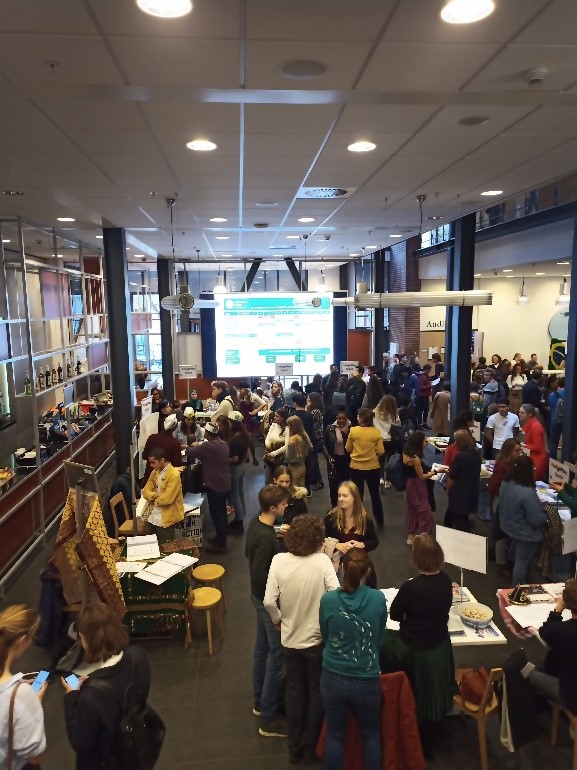
September Activity Report
30 September 2019
Global Japan Office Coordinator
TAKEMORI Banri
From the end of August to September, the weather in the Netherlands is unstable. Depending on the days, people on the streets just wear T-shirts, but on chilly days, a down jacket is a good way to avoid catching a cold. Typical autumn weather in the Netherlands is characterized by storms and showers, one of my Dutch colleagues told me that Japan’s autumn weather is placid and doesn’t have strong characteristics like the Netherlands.
On September 28, I was in Rotterdam with my colleague M Sensei. We wanted to take seats on the terrace of a café in front of a river, but a waiter told us that it would be unwise to sit there because soon it would rain. The sky was blue at that moment, but Dutch people are always well aware that a shower is likely to come in autumn even if the sun is shining at the moment.
We were in Rotterdam because there was a festival called Camera Japan Festival being held. We invited second-year students majoring in international studies that are also learning the Japanese language at the Den Haag campus, and Japanese students to visit this festival. Two Japanese students and nine students from Den Haag came on that day. Although the festival’s main attraction was movies, we attended a lecture by Luk van Haute, a versatile writer also known as a translator of Haruki Murakami, who studied Kenzaburo Oe when he was a Ph.D. student and has a career in the film industry. We headed to the venue from the Wilehelminaplein station of the metro. First, we visited a tea stall run by our colleague S Sensei, who is also a tea master. The venue was crowded and lively, especially around the stalls where our students bought Taiyaki and cups of Japanese sake, etc.
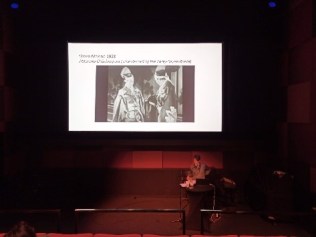
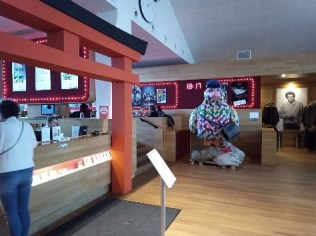
In the lecture, Mr. van Haute talked about his encounter and relationships with Chushingura. As the title “From Chushingura to AKB48” suggests, he starts with an explanation of the story Chushingura, then moved into modern show business, emphasizing the notion of “Chu (loyalty)”, an influential word in Japanese psychohistory even after the modernization of Japan, giving examples of actors “Chu” to agencies or their fans. He also showed lots of videos (from early films created by Kabuki producers to recent Hollywood films starring Keanu Reeves), which included references to not only Chushingura but also other to stories, such as “Yukoku” by Yukio Mishima, which was introduced with regards to his favorite book Hagakure, a guide to Bushido which criticized that the 47 Ronin were not sufficiently loyal to their master because they took too much time before they avenged him. He even discussed the famous Regain energy drink commercial “Can You Fight for 24 Hours?”
Lastly, on September 6, we had the first meeting with Japanese students at our Japanese conversation club. We had a lively exchange of opinions on what to do in that club. Some students said it would be no fun at all to just sit around tables and talk. They, instead, argued that it would be great if we could go to the market for example (every Wednesday and Saturday there is a market in the center of Leiden, in front of the town hall). We are planning to start our Japanese conversation club in October. Some volunteer Japanese students made a questionnaire to ask students who learn Japanese what they wanted to do in the club. After collecting the answers, we will make more concrete plans. At first, the club was not aimed at students at Den Haag, but as they told me they also wanted to do this, we had to think of a new plan.
June Activity Report
30 June 2019
Global Japan Office Coordinator
Yuri Oyama
The sunlight in the Netherlands this June was strong, and sunglasses and sunscreen were essential when going out. The other day, I went out wearing heels without putting on sunscreen, and my feet tanned in the most ridiculous way. At the end of June, the hot days just kept on coming, and some days even reached over 30 degrees.
On June 9, the 12th “Japan Markt” (Japan Festival) was held in front of Siebold Huis in Leiden. During this festival, stalls selling Japanese food and goods were set up in the street alongside the Rapenburg canal, which was bustling with people to the point where you couldn’t move. I saw some people wearing yukata or doing cosplay, and everyone seemed to be enjoying Japanese culture.
The takoyaki and sushi stands were very popular, and had long lines in front of them. At the sushi stand, the workers made the sushi on the spot, so many people were taking photos.
There were also many stalls selling Japanese goods including Japanese character goods, woodblock paintings, tableware, towels, bonsai and dyed goods. In terms of rare goods, one stall was selling heated toilet seats. There was also a stall selling secondhand randoseru (Japanese elementary school backpacks), which, according to the staff there, are a popular fashion item amongst fans of anime and manga. Come to think of it, I remember one student in the Japanese department used to come to class wearing a randoseru.
As a person who grew up in Japan, it was surprising to see some of the unexpected things that are popular as “Japanese culture” in the Netherlands. It was very interesting to learn about what Dutch people consider to be “Japanese culture”.
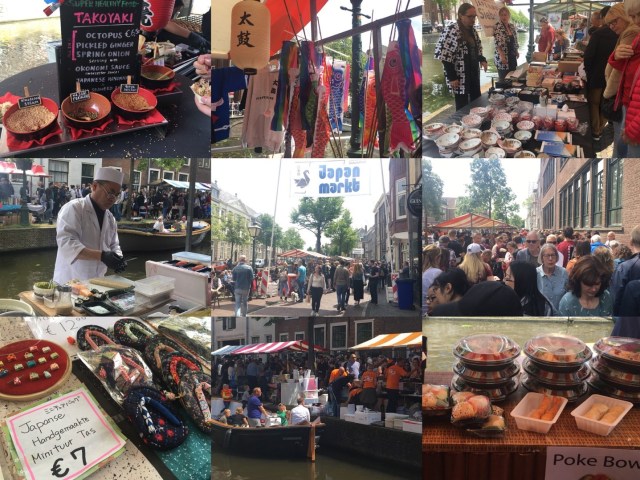
May Activity Report
31 May 2019
Global Japan Office Coordinator
Yuri Oyama
It is now May in the Netherlands, and the sun has started to stay out longer. It’s still light out after 9pm, so even at nighttime I’m not very sleepy. However, despite the sun being up longer and the days being brighter, the temperatures are still low. Mornings don’t usually go over 10 degrees, and I often found myself dressing too lightly and having to go back inside to grab a jacket before heading out.
This month, classes ended for the current academic year, and I also finished teaching my last class at Leiden University. Since it’s the end of the semester, the first-year students wrote essays based on what they had learnt in one semester, and the second-year students wrote essays using what they had learnt throughout the course as a whole. I corrected the drafts of the students’ essays, but sometimes I had trouble deciding on how to fix certain parts of them. In particular, the first-year students tended to directly translate what they wanted to say from English or Dutch into Japanese. One first-year student wrote the following sentence.
(As there are many interesting places) “Amusuterudamu wa taikutsu suru koto ga dekimasen.”
The above sentence means “I cannot get bored in Amsterdam”, and is an unnatural phrase to native Japanese speakers. I thought that perhaps the student directly translated the English phrase “I cannot get bored”, and upon asking found that they had indeed used Google Translate. However, this phrase doesn’t work in Japanese, so I had to correct it to a different one. I suggested they change the sentence to “Amusuterudamu wa tanoshii machi desu” (Amsterdam is a fun city), or “akiru koto ga arimasen” (you won’t get sick of it).
Sentences translated directly from other languages like the one above often appear in my students’ essays. Sometimes they work, but most of the time they don’t make sense in Japanese. Whenever I come across sentences like this in my students’ work, I have a hard time figuring out what the original phrase was, versus what they actually wanted to say in Japanese.
Through this semester’s final exams, I realized that, in order to teach Japanese, knowledge of a learner’s first language is necessary after all. It seems the students struggled writing such long essays, but I think it was a worthwhile task, and a good learning experience for everyone involved.
Next month will be my last month in Leiden. I will give it my all and work hard until the end.
April Activity Report
30 April 2019
Global Japan Office Coordinator
Yuri Oyama
April in the Netherlands is still cold, and people in the streets are still wearing winter clothing. I too wore my wool coat throughout the entire month.
This month there was a festival for Koningsdag on the 27th. Koningsdag is a national holiday commemorating the birth of the King of the Netherlands, which people celebrate while wearing orange (the national color of the Netherlands) clothing and accessories. While it seemed like it was going to rain, many live music stages and beer stands were set up for the occasion, and the streets of Leiden were lively with people until the early hours of the morning.
On the day of, I went to Amsterdam for the Koningsdag Festival. In Amsterdam, music was playing throughout the city, and many people were singing and dancing in the streets, beer-in-hand. There were way too many people, and sometimes you couldn’t even move around, but it was a good experience seeing a different side of Amsterdam than usual.

April’s Japanese Conversation Club was visited by the third-year students who had just returned from their study abroad in Japan. The first and second-year students asked them many questions about Japan. In particular, it seems the second-year students, many of whom will soon go on exchange to Japan, are anxious about living in Japan.
One of the third-year students talked about eating habits in Japan. This student is vegetarian, and said social gatherings with her circle were hard as there was never anything she could eat. She also said there were not many options she could eat at restaurants or the school cafeteria, and so she made most of her meals at home during her exchange.
According to news website Nu.nl’s 2018 survey of 20,000 Dutch citizens, more than 30% of respondents answered that they eat meat less frequently than they did in the past, so it seems that more and more people in the Netherlands are cutting meat out of their diets. Because of this, restaurants offering “vegetarian options” and “vegan options” are becoming more commonplace. There is even a vegan menu at the Leiden University cafeteria.
I think that the number of vegan and vegetarian exchange students in Japanese universities is also increasing. It would be good if university cafeterias, which serve to feed both students from various food cultures and university staff, could start offering vegetarian and/or vegan menus.
There are only a few things left to do for the spring semester. I aim to do my best until the very end.
